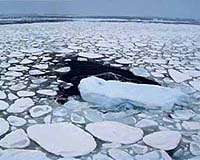| . |  |
. |
Boulder CO (SPX) May 19, 2009 While a total or partial collapse of the West Antarctic Ice Sheet as a result of warming would not raise global sea levels as high as some predict, levels on the U.S. seaboards would rise 25 percent more than the global average and threaten cities like New York, Washington, D.C., and San Francisco, according to a new study. Long thought of as the sleeping giant with respect to sea level rise, Antarctica holds about nine times the volume of ice of Greenland. Its western ice sheet, known as WAIS, is of particular interest to scientists due to its inherent instability, a result of large areas of the continent's bedrock lying below sea level. But the ice sheet's potential contribution to sea level rise has been greatly overestimated, according to new calculations. "There's a vast body of research that's looked at the likelihood of a WAIS collapse and what implications such a catastrophic event would have for the globe," said Jonathan Bamber, lead author of the study published in Science. "But all of these studies have assumed a 5-meter to 6-meter contribution to sea level rise. Our calculations show those estimates are much too large, even on a thousand-year timescale." Bamber and his colleagues found a WAIS collapse would only raise sea levels by 3.3 meters, or about 11 feet. Bamber, a professor at the University of Bristol in England, currently is a visiting fellow at the University of Colorado at Boulder's Cooperative Institute for Research in Environmental Sciences, or CIRES. The study authors used models based on glaciological theory to simulate how the massive ice sheet likely would respond if the floating ice shelves fringing the continent broke free. Vast ice shelves currently block WAIS from spilling into the Weddell and Ross seas, limiting total ice loss to the ocean. According to theory, if these floating ice shelves were removed, sizeable areas of WAIS would essentially become undammed, triggering an acceleration of the ice sheet toward the ocean and a rapid inland migration of the grounding line. The grounding line is the point where the ice sheet's margins meet the ocean and begin to float. The most unstable areas of WAIS are those sections sitting in enormous inland basins on bedrock entirely below sea level. If the ice filling these basins becomes undammed by the disappearance of floating ice shelves, it quickly would become buoyant and form new floating ice shelves further inland, in time precipitating further breakup and collapse, according to existing theories. The study authors assumed that only ice on the downward-sloping and inland-facing side of the basins would be vulnerable to collapse. They also assumed that ice grounded on bedrock that slopes upward inland or on bedrock that lies above sea level likely would survive. "Unlike the world's other major ice sheets - the East Antarctic Ice Sheet and Greenland - WAIS is the only one with such an unstable configuration," said Bamber. Just how rapid the collapse of WAIS would be is largely unknown. If such a large mass of ice steadily melted over 500 years, as has been suggested in earlier studies, it would add about 6.5 millimeters or a quarter of an inch per year to sea level rise - about twice the current rate due to all sources. "Interestingly, the pattern of sea level rise is independent of how fast or how much of the WAIS collapses," he said. "Even if the WAIS contributed only a meter of sea level rise over many years, sea levels along North America's shorelines would still increase 25 percent more than the global average," said Bamber. Regional variations in sea level would largely be driven by the distribution of ice mass from the Antarctic continent to the oceans, according to the study. With less mass at the South Pole, Earth's gravity field would weaken in the Southern Hemisphere and strengthen in the Northern Hemisphere, causing water to pile up in the northern oceans. This redistribution of mass also would affect Earth's rotation, which in turn would cause water to build up along the North American continent and in the Indian Ocean. Share This Article With Planet Earth
Related Links University of Colorado at Boulder Beyond the Ice Age
 Increasing Antarctic Sea Ice Extent Linked To The Ozone Hole
Increasing Antarctic Sea Ice Extent Linked To The Ozone HoleLondon, UK (SPX) May 07, 2009 Increased growth in Antarctic sea ice during the past 30 years is a result of changing weather patterns caused by the ozone hole according to new research published this week (Thurs 23 April 2009). Reporting in the journal Geophysical Research Letters scientists from British Antarctic Survey (BAS) and NASA say that while there has been a dramatic loss of Arctic sea ice, Antarctic sea ice ... read more |
|
| The content herein, unless otherwise known to be public domain, are Copyright 1995-2009 - SpaceDaily. AFP and UPI Wire Stories are copyright Agence France-Presse and United Press International. ESA Portal Reports are copyright European Space Agency. All NASA sourced material is public domain. Additional copyrights may apply in whole or part to other bona fide parties. Advertising does not imply endorsement,agreement or approval of any opinions, statements or information provided by SpaceDaily on any Web page published or hosted by SpaceDaily. Privacy Statement |